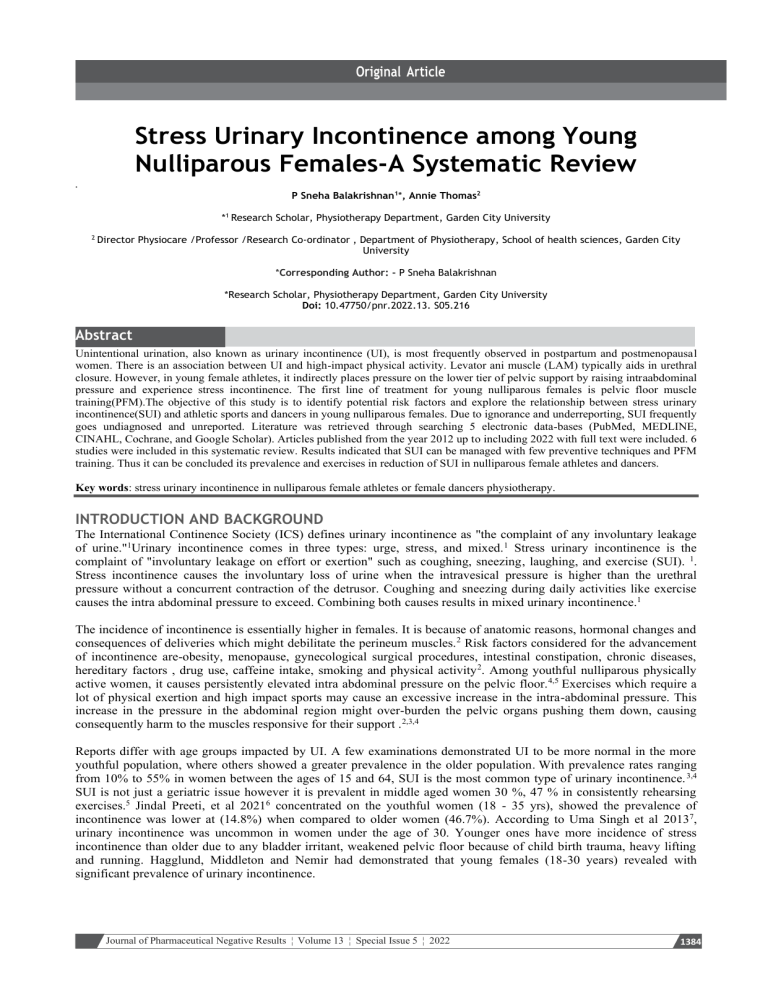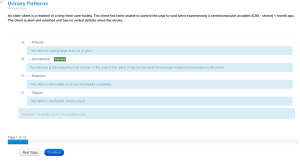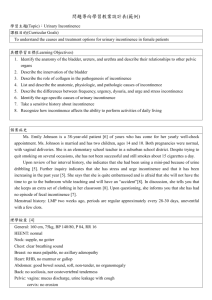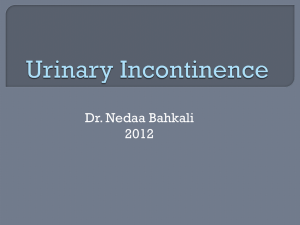
Original Article Stress Urinary Incontinence among Young Nulliparous Females-A Systematic Review . P Sneha Balakrishnan1*, Annie Thomas2 *1 Research Scholar, Physiotherapy Department, Garden City University 2 Director Physiocare /Professor /Research Co-ordinator , Department of Physiotherapy, School of health sciences, Garden City University *Corresponding Author: - P Sneha Balakrishnan *Research Scholar, Physiotherapy Department, Garden City University Doi: 10.47750/pnr.2022.13. S05.216 Abstract Unintentional urination, also known as urinary incontinence (UI), is most frequently observed in postpartum and postmenopausal women. There is an association between UI and high-impact physical activity. Levator ani muscle (LAM) typically aids in urethral closure. However, in young female athletes, it indirectly places pressure on the lower tier of pelvic support by raising intraabdominal pressure and experience stress incontinence. The first line of treatment for young nulliparous females is pelvic floor muscle training(PFM).The objective of this study is to identify potential risk factors and explore the relationship between stress urinary incontinence(SUI) and athletic sports and dancers in young nulliparous females. Due to ignorance and underreporting, SUI frequently goes undiagnosed and unreported. Literature was retrieved through searching 5 electronic data-bases (PubMed, MEDLINE, CINAHL, Cochrane, and Google Scholar). Articles published from the year 2012 up to including 2022 with full text were included. 6 studies were included in this systematic review. Results indicated that SUI can be managed with few preventive techniques and PFM training. Thus it can be concluded its prevalence and exercises in reduction of SUI in nulliparous female athletes and dancers. Key words: stress urinary incontinence in nulliparous female athletes or female dancers physiotherapy. INTRODUCTION AND BACKGROUND The International Continence Society (ICS) defines urinary incontinence as "the complaint of any involuntary leakage of urine."1Urinary incontinence comes in three types: urge, stress, and mixed. 1 Stress urinary incontinence is the complaint of "involuntary leakage on effort or exertion" such as coughing, sneezing, laughing, and exercise (SUI). 1. Stress incontinence causes the involuntary loss of urine when the intravesical pressure is higher than the urethral pressure without a concurrent contraction of the detrusor. Coughing and sneezing during daily activities like exercise causes the intra abdominal pressure to exceed. Combining both causes results in mixed urinary incontinence.1 The incidence of incontinence is essentially higher in females. It is because of anatomic reasons, hormonal changes and consequences of deliveries which might debilitate the perineum muscles. 2 Risk factors considered for the advancement of incontinence are-obesity, menopause, gynecological surgical procedures, intestinal constipation, chronic diseases, hereditary factors , drug use, caffeine intake, smoking and physical activity 2. Among youthful nulliparous physically active women, it causes persistently elevated intra abdominal pressure on the pelvic floor. 4,5 Exercises which require a lot of physical exertion and high impact sports may cause an excessive increase in the intra-abdominal pressure. This increase in the pressure in the abdominal region might over-burden the pelvic organs pushing them down, causing consequently harm to the muscles responsive for their support . 2,3,4 Reports differ with age groups impacted by UI. A few examinations demonstrated UI to be more normal in the more youthful population, where others showed a greater prevalence in the older population. With prevalence rates ranging from 10% to 55% in women between the ages of 15 and 64, SUI is the most common type of urinary incontinence. 3,4 SUI is not just a geriatric issue however it is prevalent in middle aged women 30 %, 47 % in consistently rehearsing exercises.5 Jindal Preeti, et al 20216 concentrated on the youthful women (18 - 35 yrs), showed the prevalence of incontinence was lower at (14.8%) when compared to older women (46.7%). According to Uma Singh et al 20137, urinary incontinence was uncommon in women under the age of 30. Younger ones have more incidence of stress incontinence than older due to any bladder irritant, weakened pelvic floor because of child birth trauma, heavy lifting and running. Hagglund, Middleton and Nemir had demonstrated that young females (18-30 years) revealed with significant prevalence of urinary incontinence. Journal of Pharmaceutical Negative Results ¦ Volume 13 ¦ Special Issue 5 ¦ 2022 1384 METHODS: SEARCH STRATEGY From 2012 to 2022 systematic searches of scientific literature were undertaken on Pub Med, MEDLINE, Google Scholar, Cochrane and CINAHL. In addition, reference lists of studies included in full-text screening and were manually reviewed to identify terms searched under 3 concepts: female dancers, female athletes, stress urinary incontinence nulliparous women. STUDY SELECTION: ELIGIBILITY CRITERIAStudies were included if they: 1) Published as a full-text article in a peer-reviewed journal in English 2) Included young adult patients, with age criteria from 18 yr old to 40 yr old 3) The sample size was never below 10,4) Subjects were diagnosed with stress urinary incontinence according to cough stress test.5) Included females athletes with SUI or female dancers with SUI ,6) Studies from 2012 until 2022 7) At least one of the following parameters was measured: QUID, KHQ, RUIS, UDI, IIQ and other evaluations concerning incontinence. The title, abstract and keywords of each article were assessed to determine if it fulfilled the inclusion criteria outlined above. Studies which met inclusion criteria were included for the review and analyzed. METHODOLOGICAL QUALITY ASSESSMENT: Each study was assessed for methodological quality using 10 criteria (see below -Table 1). These criteria were from the Pedro scale .The articles were evaluated for methodological quality by reviewers using the PEDro scale, which contains 11 yes/no items. A PEDro score was calculated by adding up all the “yes” answers from items 2 to 11. The first item was not used to calculate the PEDro score because it evaluates the external validity of trial results. A high-quality study was defined as scoring positive in at least 50% (5/10) of the items, and a low-quality study was defined as scoring positive in less than 50% of the items. Table1-Methodological quality score of the 6 studies. authors 1 2 3 4 5 6 7 8 9 10 11 Dr. K. Murugavel L Mahalakshmi Piernicka M et al Chavan P et al Musale R et al Rashida et al + + + + + + + + + - - + + + + - - - - _ + + + + + - + + + + - + + + + + + Total score 5/10 6/10 6/10 2/10 6/10 3/10 Quality of the study high high high low high low DATA EXTRACTION – The selection of studies and data extraction was carried by reviewer. The systematic search according to criteria with key terms SUI nulliparous female athletes or female dancers physiotherapy identified 364 articles in Google scholar, of which 29 were assessed and fit the initial criteria, 9 articles in Pub med, of which one fit the inclusion criteria (articles in English and full text).Other articles were excluded with full text not available, language other than English, age criteria above 40 yr old and reviews which does not fall in the search criteria. Figure 1 Flow diagram for data screening process ANALYSIS: All relevant studies were stratified by their purposes ie: impact, physiotherapy treatment, or disability reduction). Exercises were classified as muscle strengthening for pelvic floor and core muscles, physiotherapy techniques for treatment of stress urinary incontinence. Nulliparous young women in this study includes female athletes and dancers. The main reason for including female athletes as they are featured in the majority of articles containing prevalence studies and in female dancers related to its prevalence as well as the effectiveness of treatment. 1385 Journal of Pharmaceutical Negative Results ¦ Volume 13 ¦Special Issue 5 ¦ 2022 PREVALENCE OF SUI IN RELATION TO PHYSICAL ACTIVITY: 1. Female athletes Female athletes are defined as participants playing intercollegiate tournaments at university level while women participating in recreational exercise were represented to a lesser extent in this study. Elite athletes are the ones who are having long hours of exercise training or talented athletes within a particular group, place or society.SUI has been reported to occur in two third of female gymnast and 28% of female college athletes. 8 In 1994 it reported elite athletes 28% experience urinary incontinence during exercise with activities like jump with open legs and jump with closed legs, running, and sports with high impact landing. 4 In any case, it is particularly noted in exercises that includes persistent, repetitive movement.9 Overall athletes show more abdominal musculature strength which can be a variable for increased intra abdominal pressure. This inclines pelvic floor weakness causing episodes of urine leakage in young physically active nulliparous women without other risk factors.9.The American Urogynecologic Society's site suggests that women should avoid heavy lifting and high impact activity that makes an increase in the abdominal pressure to prevent pelvic floor dysfunction. 10 Type of sport as a risk factor of SUI – In actuality, women who engage in repetitive, high-impact sports like running, jumping and physical education students are most susceptible to urinary incontinence.11,12.The highest risk sports for SUI in female athletes are track and field (long jump, triple jump, high jump, hurdles) gymnastics (floor exercises, asymmetric bars, trampolining), basketball, volleyball, handball, combat sports (karate, judo), bodybuilding, and horseback riding. 9Tennis players, skiers, skaters, and joggers also frequently experience SUI. There is high prevalence of SUI in elite athletes who undergo high intensity training.12There is prevalence of SUI in different sports like crossfit 13, kickboxing, boot camp14,powerlifters.15UI and AI were highly prevalent in female gymnasts and cheerleaders.16 Altered pelvic floor and response to physical activityAccording to the "hammock hypothesis," an increase in intra-abdominal pressure stretches the pelvic ligaments and floor muscles, resulting in fatigued muscles and long-term tissue damage. It results in an imbalance between the upward pressure from PFM and the downward force from the abdomen, which can result in SUI. Leakage occurs more frequently late in the day and during high-impact exercises due to SUI caused by muscular fatigue. 14Women that are unable to contract their PFMs may strain or contract other muscles such as the hip adductors, abdominals, and gluteus muscles. Elite female athletes experience sudden increases in intra-abdominal pressure (IAP) that can cause SUI owing to the lack of, weak, or delayed co-contraction of the PFMs and other muscle groups. 14 2. Female Dancers Recently, it has been discovered that dancers frequently experience stress incontinence. 22.5% female dancers reported experience of stress urinary incontinence. It is because of long time dancers spend rehearsing and performing, overuse injuries which is very common. Bharatanatyam dancers 28%, hip hop style dancers – 50%where there is more utilization of lower extremity that leads to increased flexibility of lower limb. 23 Bharatanatyam dancer’s stancesaraimandi which is squatting position with the two arms extended for a longer time over-burden with body weight of a person. This dance pose includes both the activation of abdomen and pelvic floor muscles, which bring about increase in intra-abdominal pressure to stabilize the lower limbs in the same posture. This posture is similar in ballet form which gives pressure in the lower tier of pelvic support. 12Urinary incontinence was more in between 6-10 yrs training period which was due to overuse injuries in them that have caused because of postures attained or increased tightness of lower extremity. 17 ASSOCIATION OF SUI AND DANCERS The demi plié and grand plié ballet positions and two Bharatanatyam positions called aramandi and muzumandi include turnout and knee bending. Although the stances in the two dances are similar, the technique behind each position varies greatly on the knee angle. The knee joint's extreme bent angle in Indian classical dancers adds to higher burden on the joint. Bharatanatyam and ballet dancer’s positions likely to engage gluteal, quadriceps, and hamstrings muscle groups to hold the position .An absence of muscle engagement can add to a lot of burden on the knee joint. The ballet dancers hamstring flexibility exceeded that of the Bharatanatyam dancers, which could be because of addition stretching and warm-up sessions in it. In half-sitting positions, for both the Bharatanatyam and ballet performer’s average peak force for one foot in terms of body weight was over 50% and in the full-sitting position, peak force was higher in the Bharatanatyam dancers than in the ballet dancers. The moments calculated were higher in the full-sitting positions compared to the half-sitting positions supporting knee moment increased as knee flexion increased. As the results of this study have shown, all four poses between both dances forms require forces that exceed body weight and bent knees. While these poses may not cause immediate damage, holding them for sustained periods of time over many years could increase risk of wear and tear injury 18 Journal of Pharmaceutical Negative Results ¦ Volume 13 ¦ Special Issue 5 ¦ 2022 1386 Table 1: articles under this review SSC- Sandvik Severity Scale, SUI, stress urinary incontinence;; QUID Questionnaire urinary incontinence diagnosis, KHQ ,King’s Health Queastionnaire, IIQ Incontinence Impact Questionnaire; MOGS-modified Oxford Grading Scale. Author and year of publication Prajakta chavan et al 2022 age Study design sample assessment results 18-35 YRS Analytical-RCTOne week follow up 50 female dancers UI QUIZ UI knowledge scale Piernicka et al. 2021 19-28 yr old RCT 6 weeks follow up 32 female college students Biofeedback(MVC) IIQ Rashida Hakim Hamid et.al. 2020 18-25 yr old RCT one month follow up 30 nulliparous females QUID KHQ Rima Musale et al 2020 18-25 yr old RCT 6 weeks follow up 90 female dancers IIQ and pad test Murugavel K 2018 17-25 yr old RCT 16 weeks follow up 45 intercollegiate athletes 17-25 yr old RCT 16 weeks follow up 45physically active collegiate females Sandvik Severity Scale (SSC) and Modified Oxford Grading Scale (MOGS),KHQ Sprint testing,J ump testing MOGS,100 MT Sprint Incontinence quiz score post intervention mean was 11.32±1.71 with p<0.0001 which is extremely significant, For incontinence knowledge scale the post intervention mean was 24.2±2.81 with p <0.0001 which is extremely significant An increase in MVC AND IIQthe treatment group with high impact aerobic programme on PFM Kegel exercises have a significant effect in reducing the severity of stress urinary incontinence related to menstrual cycle and quality of life. IIQ -For group C which is very significant, while comparing group A B and C IIQ which is not significant. Pad test for group A,B,C is significant, while comparing group A B and C Pad test post values p<0.08812 which is not significant. combination of physiotherapeutic techniques and core muscles strength training had greatly improved L Mahalakshmi 2013 physiotherapeutic techniques and core muscle strengthening exercises improving athletic performance RESULTS Search Strategy: A total of 30 articles were judged to meet the selection criteria. The article with the highest methodological quality was included. Thus, 6 publications were assessed for methodological quality and data extraction.19,20,21,22,23,24 Study Characteristics: Four of the six trials studied subjects with nulliparous physically active females or intercollegiate athletes. Two trials reported on female dancers. Of the 6 trials, 1 trial studied in subjects with urinary incontinence, 3 trials examined those with stress urinary incontinence. The remaining 2 trial state clearly physically active nulliparous women. Of the 6 included studies, 3 examined the effectiveness of specific types of exercise in stress urinary incontinence. The remaining 3 investigated either 2 combined exercise therapies. Three studies compared pelvic floor to core strengthening exercises. Two studies measured outcomes at 12-month follow-ups. The remaining 4 studies had shorter follow-up periods, ranging from 1 week to 6 weeks. ANALYSIS Pelvic floor exercises for reduction of SUI in nulliparous females and improve quality of life. Low evidence - P value pre and post scores of QUID SUI is less than 0.05 which is significant. Pre and posttest values of KHQ1 KHQ2 and KHQ3 showed that P-Value is less than 0.05 for KHQ1. Hence we conclude that effect observed is significant for KHQ1.19 Pelvic floor exercises combined with other exercises for reduction of SUI and improves athletic performance in active nulliparous university atheletes -High evidence -Combination of physiotherapeutic techniques and core muscles strength training had greatly improved results in MOGS , SSS general health, incontinent impact ,role limitation ,physical limitation, social limitation ,emotion , sleep , and severity and athletic performance in jump and sprint.20High evidence-the combination of physiotherapeutic techniques with core muscle strengthening exercises given for 16 weeks improves the condition of stress urinary incontinence in collegiate females and marked improvement in athletic performance of 100 meters sprint was observed. 21High evidence - maximum voluntary pelvic floor muscle contractions after 6 weeks, values have raised by 5% in the experimental group and by 2% in the control group and improvement in IIQ22 1387 Journal of Pharmaceutical Negative Results ¦ Volume 13 ¦Special Issue 5 ¦ 2022 Combined physiotherapy techniques with core stability exercises for female dancers with stress urinary incontinence-Low evidence -urinary incontinence knowledge and its different treatment options before was 15.72±3.32 and post intervention was 24.2±2.81. 23High evidence - IIQ and Pad test within the group comparisons and between the group comparisons within Confidence interval of 95%, showing difference within the groups is significant and between the groups is not significant. 24 DISCUSSIONS: Exercise interventions reported in this review included pelvic floor exercises, core stability exercises, and aerobic exercises. We found heterogeneity among studies in terms of the population studied, exercise regimen, control treatment, and follow-up period. Two of the included studies did not specify stress urinary incontinence characteristics. Stress urinary incontinence mainly arises from pelvic floor weakness .So pelvic floor strengthening exercises works best to treat stress urinary incontinence. Different exercise regimens in terms of exercise type, intensity, duration, and frequency were evaluated among the included studies. Thus, the current state of the literature limits comparability between trials. Conclusions can be drawn only on the general characteristics of exercise regimens that have been found effective. Limitations of this review-There are 2 main methodological limitations that are noteworthy. First, the search strategy was limited only to full reports published in English. The possibility of publication and selection bias cannot be ruled out, which may affect the results of the review. Second, the researchers summarized the results from studies with substantial heterogeneity in study characteristics. This may explain the observed variation in the results among studies. Future research is required to indicate whether differences in these aspects affect the effectiveness of exercise intervention before direct comparisons among different combinations of exercise programs can be conducted. CONCLUSIONS: This Review article has shown that there has been an increased SUI, among young nulliparous females, athletes and dancers. SUI happens because of a repeated increase in intra-abdominal pressure prompting a weakened PFM. It is overseen moderately with few preventive techniques and PFM training. Pharmacological and careful treatments like surgeries are viewed as just in serious cases. Later on, predominantly those engaged with ladies medical care, ought to be urged to instruct patients, particularly young nulliparous females athletes and dancers about stress urinary incontinence. There is a need for screening of SUI in young nulliparous physically active women. In the upcoming years, more study will be required to fully comprehend this observation. FUNDING SOURCES – The authors declare there is no funding CONFLICTS OF INTEREST– There is no conflict of interests. ETHICAL CLEARANCEEthical clearance will not be required because this study retrieves and synthesize data from already published studies. REFERENCES: 1. 2. 3. 4. 5. 6. 7. 8. 9. 10. 11. 12. 13. 14. Abrams P, Cardozo L, Fall M, et al. The standardisation of terminology of lower urinary tract function: Report from the standardisation subcommittee of the international continence society. Am J Obstet Gynecol. 2002;187: 116-126. Caetano.A, Tavares. Cunha et al. Urinary Incontinence and physical activity practice. Rev Bras Med Esporte 2007. Vol. 13, Jul/Aug, No 4 Bø K. Urinary incontinence, pelvic floor dysfunction, exercise and sport. Sports Med.2004; 34:451-464. Silva,Lissandra Henrique et al. The relationship between stress urinary incontinence and exercises in nulliparous women.Salusvita,Bauru, 2005.v.24, no 2,p 207-218.. Vinal Charpot and Vaishali Sagar. Prevalence of urinary incontinence among young healthy females in Gujarat - a cross sectional study. International Journal of health Sciences and Research, 2021, June, Vol.11; Issue: 6. Jindal Preeti1, Gupta Madhu2,et al. Female Urinary Incontinence - A Revisit on Prevalence of this Problem in Today’s Society, which is Increasing due to Increase in Average Life Span. Acta Scientific Women's Health 3.9 (2021): 27-33. Uma Singh, et al.Prevalence and risk factors of urinary incontinence in Indian women: A hospital-based survey. Indian Journal of Urology, 2013,Jan-March Vol 29, Issue 1, Thyssen HH, Clevin L, Olesen S, Lose G. Urinary incontinence in elite female athletes and dancers. Int Urogynecol J Pelvic Floor Dysfunct. 2002; 13:15-17.. Kelly I. Daly, Jennifer Doherty-Restrepo, Stress Urinary Incontinence in Female Athletes by core.ac.uk.2013.Florida International University. Joseph et al. Stress Urinary Incontinence among Young Nulliparous Female Athletes. Cureus 2021, 13(9): e17986. Renata Veloso Teixeira et al. Prevalence of urinary incontinence in female athletes: a systematic review with meta-analysis. International Urogynecology Journal. https://doi.org/10.1007/s00192-018-3651-1. Anna Poświata et al. Prevalence of Stress Urinary Incontinence in Elite Female Endurance Athletes. Journal of Human Kinetics 2014.Volume 44. Carlos Ayán et al. Prevalence of urinary incontinence in female CrossFit athletes: a systematic review with meta‑analysis. International Urogynecology Journal 2022. Iman Akef Khowailed et al. Stress incontinence during different high-impact exercises in women: a pilot survey. Int. J. Environ. Res. Public Health 2020, 17, 8372. Journal of Pharmaceutical Negative Results ¦ Volume 13 ¦ Special Issue 5 ¦ 2022 1388 15. Wikander et al. Urinary Incontinence in Competitive Women Powerlifters: A Cross‑Sectional Survey Sports Medicine - Open 2021. 7:89 16. Kristina Lindquist Skaug et al. Urinary and anal incontinence among female gymnasts and cheerleaders—bother and associated factors. A crosssectional study. International Urogynecology Journal 2022. 33:955–964. 17. .Arati Mahishale et al.Screening of urinary incontinence among female dancers-a cross sectional study. Research journal of obstetrics and gynaecology.2018.11, 31:35. 18. Roshni Prakash. Musculoskeletal effects and injury risk in collegiate Indian classical and ballet dancers. Department of Evolutionary Anthropology, Duke University 2015-2016. 19. Rashida Hakim Hamid et al. Effect of Pelvic Floor Exercises on Urinary Incontinence Related to Menstrual Cycle and Quality of Life. International Journal of Health Sciences and Research 2020 October Vol 10; Issue 10. 20. Dr. K. Murugavel. Efficacy of core muscle strength exercises and physiotherapeutic techniques on stress urinary incontinence and performance of female athletes. Journal of Emerging Technologies and Innovative Research 2018, January Volume 5, Issue 1. 21. L. Mahalakshmi. Effects of Physiotherapeutic Techniques and Combination of Physiotherapeutic Techniques with Core Muscle Strengthening Exercises on Stress Urinary Incontinence and Performance in Athletic Event among Collegiate Females International Journal of Science and Research (IJSR),2013. July, Volume 2 Issue 7. 22. Piernicka M et al. High-impact aerobics programme supplemented by pelvic floor muscle training does not impair the function of pelvic floor muscles in active nulliparous women A randomized control trial. Medicine 2021, 100:33. 23. Prajakta Chavan, Rima Musale, Neha Bhosalet al. Effect of Knowledge and Awareness Regarding Urinary Incontinence and Its Treatment Options in Female Dancers. Indian Journal of Physiotherapy and Occupational Therapy. April-June 2022, Vol. 16, No.2. 24. Rima Musale et al. Effectivnesss of Physiotherapy Interventions on Stress Urinary Incontinence in Female Dancers. Indian Journal of Public Health Research & Development, June 2020, Vol.11, No.6. 1389 Journal of Pharmaceutical Negative Results ¦ Volume 13 ¦Special Issue 5 ¦ 2022 Copyright of Journal of Pharmaceutical Negative Results is the property of ResearchTrentz and its content may not be copied or emailed to multiple sites or posted to a listserv without the copyright holder's express written permission. However, users may print, download, or email articles for individual use.




